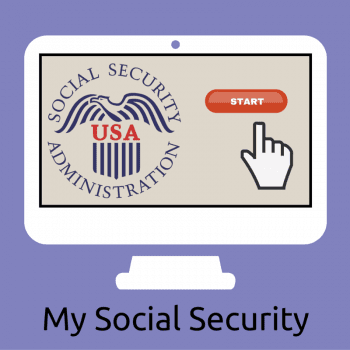Dude – Where’s my Social Security Statement?
 We received them annually. They were white with green stripes, and they gave us some comfort in knowing that all of those Social Security taxes we’d paid over our lives were actually going to yield us something. Then, in 2011, they stopped coming.
We received them annually. They were white with green stripes, and they gave us some comfort in knowing that all of those Social Security taxes we’d paid over our lives were actually going to yield us something. Then, in 2011, they stopped coming.
For some of us, we didn’t notice. For lots of others, it was troubling. There was such a backlash against it that in 2014, the Social Security Administration re-started its mailing of statements (but only every five years for those under 60).
But last year, stresses on the budgets at SSA, coupled with tight human resources (there is a backlog of over 1,000,000 people awaiting disposition of their Social Security disability claims) caused the agency to, again, discontinue the mailing of statements.
The good news is that the SSA has fully emerged into the 21st century and has vastly improved its online resources. Thanks to “my Social Security” on ssa.gov, accessing your Social Security statement 24 hours a day, 365 days a year is easier than walking out to your mailbox.[1]
Our advice? Go to ssa.gov and set up a mySocialSecurity account. It’s actually really easy. Once there, make a plan to review your statement once per year. You can access the same friendly form, green stripes and all. One of the major reasons to check your statement regularly is that you are the only auditor of this record. No one else is going to make sure that all SS-eligible income is being reported. Sure, 98 percent of earnings are reported correctly, but errors do occur. If there is an error or an omission, you’ll want to catch it while you still have documentation to back up your claim. Just one missing year of earnings can reduce your benefit by over $100/month for life!
Another obvious reason for checking your statement regularly is that we want that data for your financial plan. This is an important part of your retirement income scenario. Your benefit projection will likely vary from year to year, so keeping it up-to-date in your plan will require occasional reviewing.
Now that you’ve checked to make sure that your earnings record is accurate, keep in mind that the numbers shown on the statement are probably not the amounts that you’ll actually receive. That’s okay, because we can still use them in planning, but why aren’t they exact? Lots of reasons:
- Especially if you’re younger, your earnings record will continue to fill out over time, likely on a different trajectory than is assumed in the statement.
- The numbers listed on your statement are given in present value. In other words, they are likely to increase between when you look at your statement and when you receive your benefit, due to inflation.
- You might not receive benefits based upon your record. If you’re married, you may receive benefits on your spouse’s record. If you’re divorced, you may receive benefits on an ex-spouse’s record, and if you’re widowed, you may receive benefits on your former spouse’s record.
- Your benefit may be reduced if you’ve worked for an employer that doesn’t participate in Social Security. For certain professions, including for school teachers in states including Maine, a ‘Windfall Elimination Provision’ and a ‘Government Pension Offset’ exist, which will likely reduce benefits below what is estimated.
- Right there – on the statement – Social Security admits that it really doesn’t have the resources to pay you the benefits shown. It says “by 2034, the payroll taxes collected will be enough to pay only about 77 percent of scheduled benefits.” This, by the way, is not a new admission. This shortfall has been projected for more than 20 years. Each year, the steps required to fix this shortfall become more draconian. Call your congressman or congresswoman. Meanwhile, it might be prudent to downsize your expectations for Social Security, especially if you’re young.
The statement will provide multiple estimates of your benefit. One is at age 62, one at age 70, and one at your “Full Retirement Age”. One thing the statement will NOT provide is any information on when is best to start taking your benefits. Lots of considerations there, especially for married couples.
So, no need to mourn the demise of the paper statement, but consider this to be your first reminder to check your statement. We’ll leave it up to you to decide upon how you’ll remind yourself annually going forward!
[1] Actually, if you still want to receive a paper statement, you can order one on the ssa.gov website. Additionally, individuals over 60 years old who haven’t yet set up an account on mySocialSecurity will continue to receive paper statements until they sign up for benefits.



